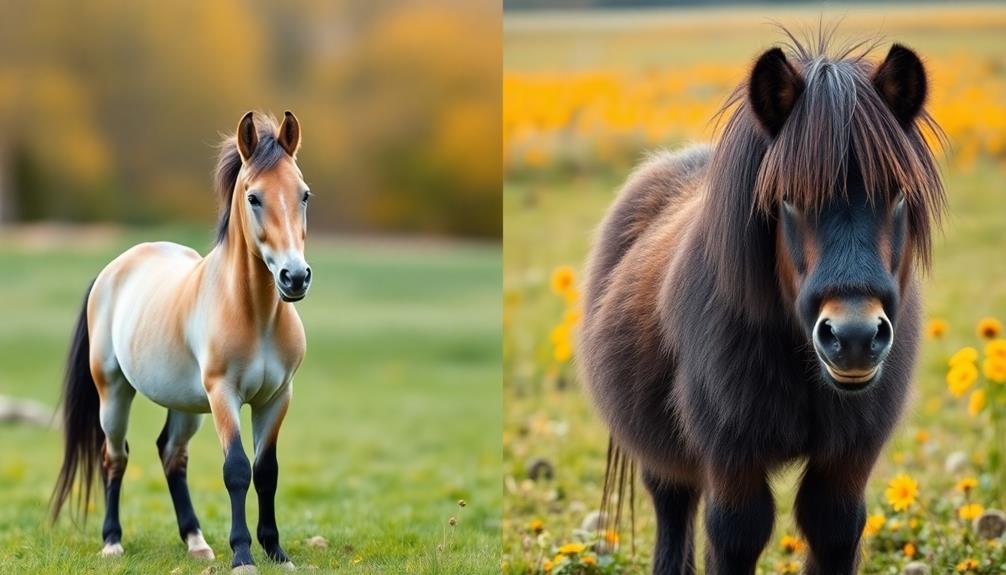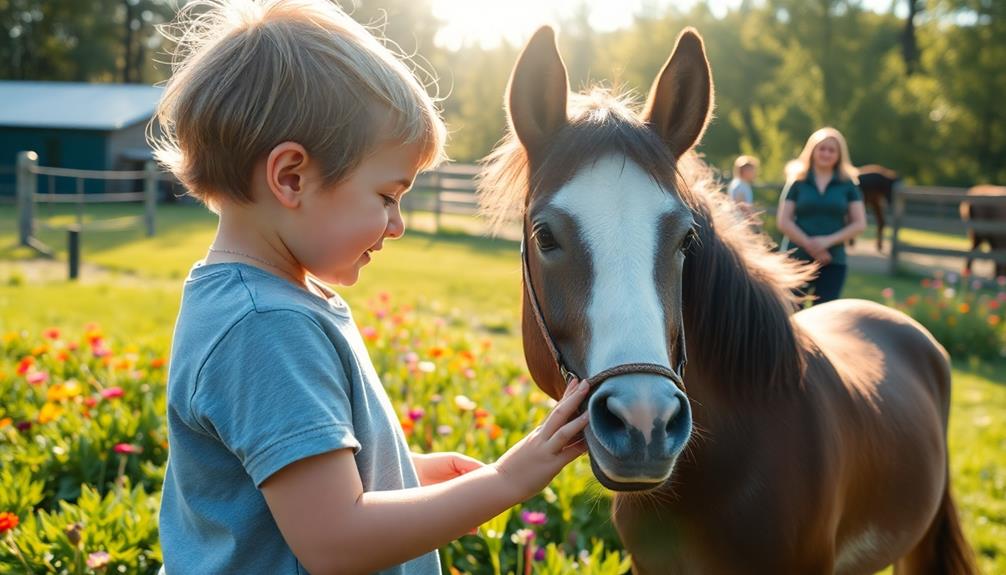Miniature horses and ponies are often mistaken for one another, but they have distinct differences. Miniature horses stand up to 38 inches tall, while ponies measure under 14.2 hands. Physically, miniature horses resemble full-sized horses, while ponies are stockier and have thicker necks. Behaviorally, ponies can be clever and require experienced handling, whereas miniature horses are usually gentle and easier to manage. Understanding these contrasts is essential for proper care and ownership. If you want to explore more about their uses, origins, and unique traits, there's plenty more to discover!
Key Takeaways
- Ponies measure under 14.2 hands, while miniature horses max out at 38 inches in height, with some breeds classified under 34 inches.
- Miniature horses resemble full-sized horses in proportion, whereas ponies typically have stockier builds and thicker necks.
- Ponies are clever and may require experienced handlers, while miniature horses are generally gentle and easier to manage.
- Miniature horses often serve as therapy animals, while ponies are commonly used for children's riding and agricultural work.
- The initial costs for ponies often exceed $10,000, whereas miniature horses are generally more affordable, with prices starting around $1,000.
Definitions and Key Differences

When you explore the world of equines, you'll quickly notice some key differences between miniature horses and ponies. One of the primary distinctions lies in size. Ponies are defined as equines measuring under 14.2 hands (58 inches) tall, while miniature horses have a maximum height of 38 inches (9.5 hands). This creates a fascinating landscape of miniature horses vs. ponies, even when their sizes overlap.
Understanding the characteristics of BPD can also shed light on how emotional factors might influence one's connection to animals, including preferences for certain breeds.
In addition to height, the physical characteristics set them apart. Miniature horses possess a horse-like appearance with refined features, while ponies are stockier, with thicker necks and shorter legs. The American Miniature Horse Association (AMHA) further specifies that miniature horses must be under 34 inches tall for registration, which helps clarify their classification.
Misclassification often happens due to marketing, leading to confusion between "mini horse" and "pony." Understanding these differences between horses can enhance your appreciation for both types.
Whether you're drawn to the elegance of a miniature horse or the sturdy charm of a pony, knowing their unique traits allows you to make informed decisions in your equine journey.
Size and Classification
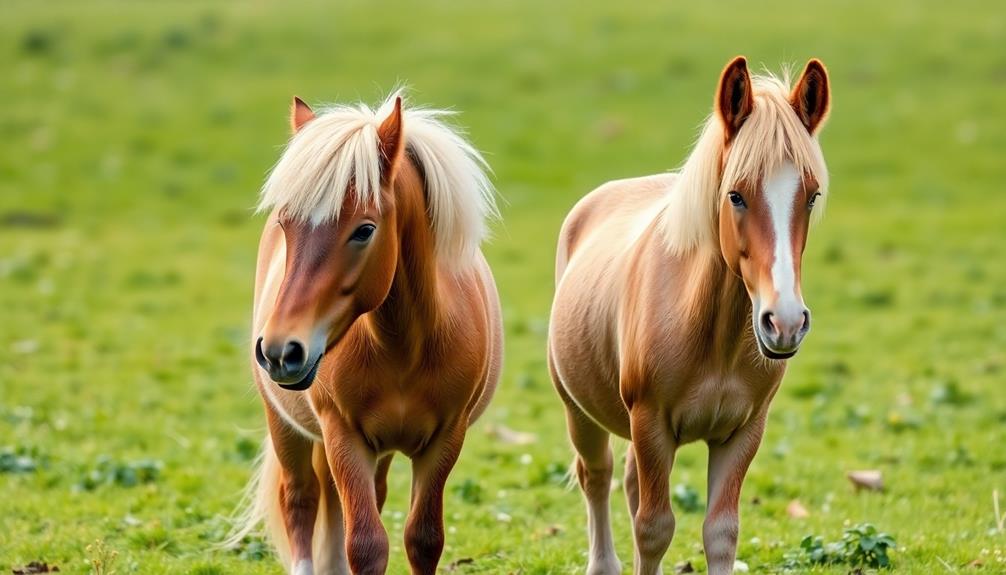
Understanding the nuances of size and classification in equines is essential for anyone interested in miniature horses and ponies. The distinction between these two types hinges primarily on height. Miniature horses measure a maximum of 38 inches (9.5 hands) tall, while ponies stand under 14.2 hands (58 inches). The American Miniature Horse Association (AMHA) takes this further, requiring registered miniature horses to be under 34 inches tall.
Here's a quick comparison:
| Classification | Height |
|---|---|
| Miniature Horses | Up to 38 inches |
| Registered Miniatures | Under 34 inches |
| Ponies | Under 14.2 hands |
| Arabians | Any height |
| Misclassification | Common in marketing |
Ponies generally have a stockier build, featuring thicker coats, shorter legs, and wider barrels, contrasting with the more refined physique of miniature horses. Misclassification can create confusion, especially when marketing terms like "mini horse" are used interchangeably with "pony." Understanding these size and classification differences is crucial for making informed decisions in equine ownership or care.
Physical Abilities and Health
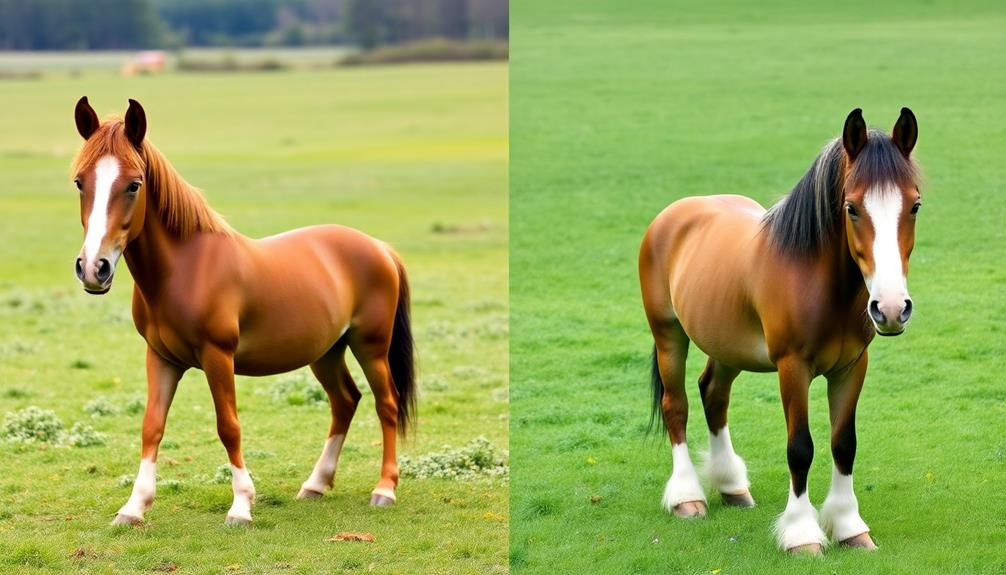
In the domain of equines, miniature horses and ponies share many physical abilities but also exhibit distinct differences in their health requirements. Both have similar digestive, respiratory, and musculoskeletal systems. However, when it comes to diet, ponies and miniature horses generally need fewer calories than full-sized horses for maintenance.
Understanding common financial terms can also be beneficial for horse owners managing costs. Miniature horses are versatile and can perform tasks like driving and in-hand showmanship, showcasing their unique capabilities despite their size.
Ponies, being stockier and hardier, are particularly suited for children and small adults, with a recommended rider weight limit of under 20% of their body weight. Yet, both miniature horses and ponies are at risk for health issues.
Obesity can lead to serious conditions like Equine Metabolic Syndrome (EMS) and laminitis, making weight management critical for their overall well-being. Regular veterinary care, including vaccinations, deworming, and dental exams, is essential for maintaining equine health in both types.
Behavioral Traits
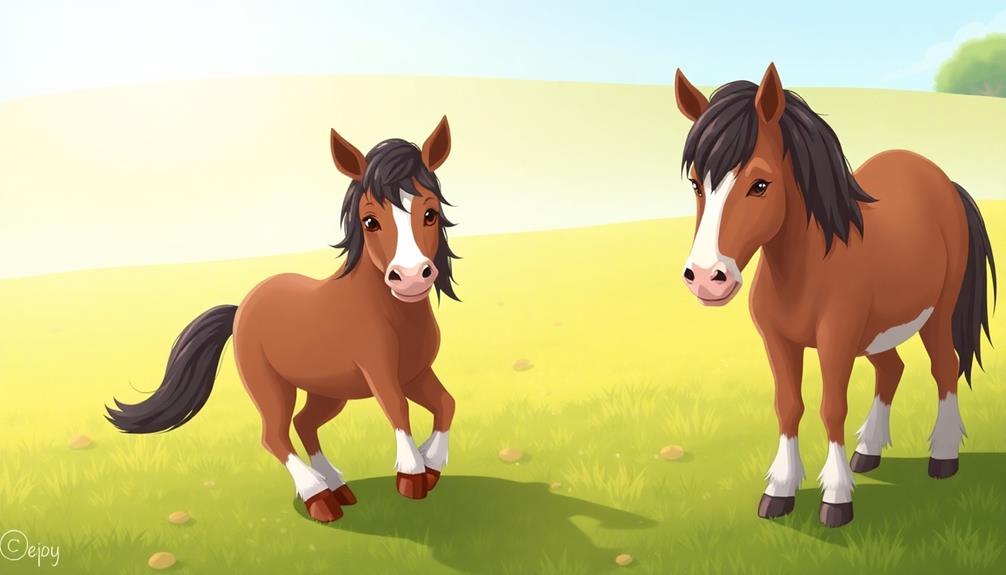
When it comes to behavioral traits, you'll find significant differences between ponies and miniature horses. Ponies can be quite clever and may outsmart inexperienced handlers, leading to some mischievous antics, while miniature horses tend to be gentle and affectionate.
Understanding their handling and training needs is essential, as their cognitive similarities with full-sized horses come with unique behavioral challenges. Additionally, just as with infants, understanding their developmental milestones can help in shaping their behavior and training approach.
This awareness can lead to more effective communication and bonding between humans and these charming equines.
Handling and Training Needs
Handling and training needs for ponies and miniature horses can vary markedly due to their distinct behavioral traits. Ponies often need experienced handlers who can navigate their cleverness. If you're new to riding or handling, you might find that ponies can easily outsmart you, leading to behavioral challenges.
To train a pony effectively, consistency and positive reinforcement are essential. This approach helps mitigate the mischievous tendencies that can arise with less experienced handlers.
On the other hand, miniature horses are generally easier to manage. They display gentle and affectionate temperaments, making them well-suited for therapy roles and companionship.
While both ponies and minis share similar cognitive abilities, their behavioral differences often stem from the handling experience you bring to the table.
When training either type, understanding their unique characteristics is vital. Ponies tend to be stockier and more robust, while minis are more refined and may learn at different paces.
Tailoring your training methods to suit these behavioral differences can lead to a more rewarding experience for both you and your equine companion.
Mischievous Behavior Tendencies
Ponies are often seen as the playful troublemakers of the equine world, thanks to their cleverness and strong personalities. Their intelligence allows them to outsmart inexperienced riders, leading to mischievous behavior that can be both amusing and frustrating.
With their stocky build and spirited nature, ponies tend to test boundaries during training, which can result in playful antics that some may misinterpret as stubbornness. If you're new to handling ponies, this misunderstanding can lead to negative training outcomes.
On the other hand, Miniature Horses, while also intelligent, generally exhibit gentler behavior. They're less likely to engage in mischievous actions compared to their pony counterparts. This means you might find Miniature Horses easier to manage, especially if you're still honing your skills as a handler.
However, don't let the pony's reputation deter you! With proper handling and training from experienced individuals, you can effectively mitigate their mischievous tendencies.
Establishing clear boundaries and consistent discipline will help guarantee that these playful equines become delightful companions rather than troublesome ones. Embrace the challenge, and you'll build a rewarding relationship with either a pony or a Miniature Horse!
Cognitive Similarity Factors
Exploring the cognitive traits of ponies and Miniature Horses reveals fascinating similarities that challenge common misconceptions. While you might think that cognitive differences exist between them, you'll find that both possess similar cognitive abilities.
The variations in behavior often stem from rider experience and handling techniques rather than any intrinsic differences in intelligence or temperament.
Ponies are known for their cunning behavior, which can lead them to outsmart inexperienced riders. This highlights the importance of having experienced handlers who can effectively train them.
With the right guidance, you'll notice that both ponies and Miniature Horses can thrive in various environments and tasks. However, ponies may show a greater capacity for mischief due to their intelligence and adaptability.
Many misunderstandings about pony behavior arise not from the ponies themselves but from the inexperience of their riders. By recognizing that both creatures share similar cognitive traits, you can better appreciate their unique personalities.
Whether you're working with a pony or a Miniature Horse, the key to success lies in understanding their behavioral traits and applying proper training techniques.
History and Origin
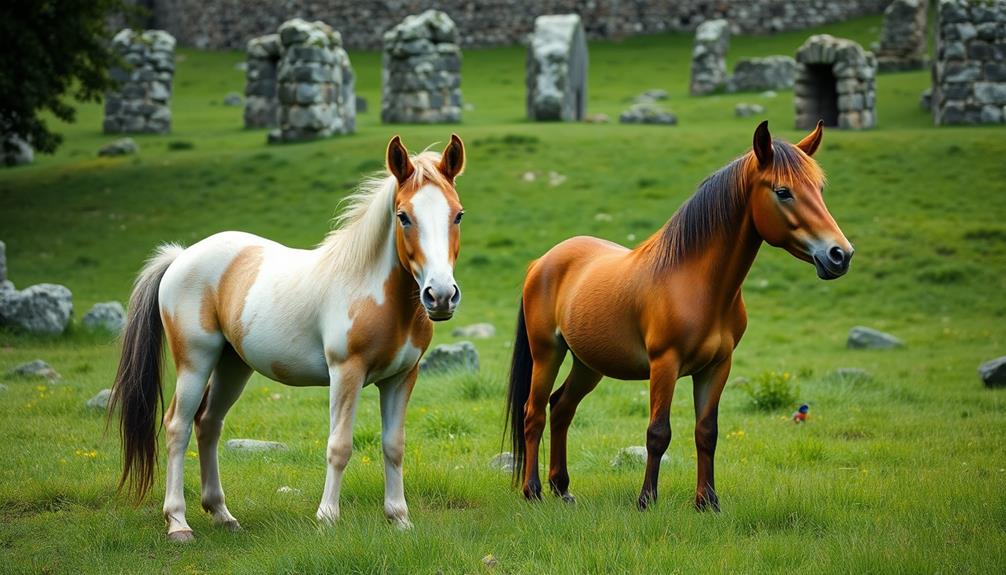
The fascinating history of Miniature Horses and ponies reveals their unique origins and purposes. Miniature Horses first appeared in 1650 at the Palace of Versailles, bred specifically for their small size and gentle nature. Their compact stature made them ideal working animals, especially in coal mines across England and Northern Europe, where they showcased remarkable strength despite their size.
In the U.S., the first recorded Miniature Horse was a 31-inch Shetland named Yum-Yum, who gained popularity in the 1800s. These horses were developed through selective breeding, combining small horses and Shetland ponies, which maintained a genetic link while creating a distinct breed.
On the other hand, ponies have been domesticated in the U.S. since the 1800s, primarily for agricultural work. Wild ponies, such as those found on Assateague Island, have existed since at least the 1600s, showcasing their long-standing presence in American history.
Understanding the history of Miniature Horses and ponies helps you appreciate their roles in society, from working animals to beloved companions, each with a rich background that distinguishes them from one another.
Common Breeds
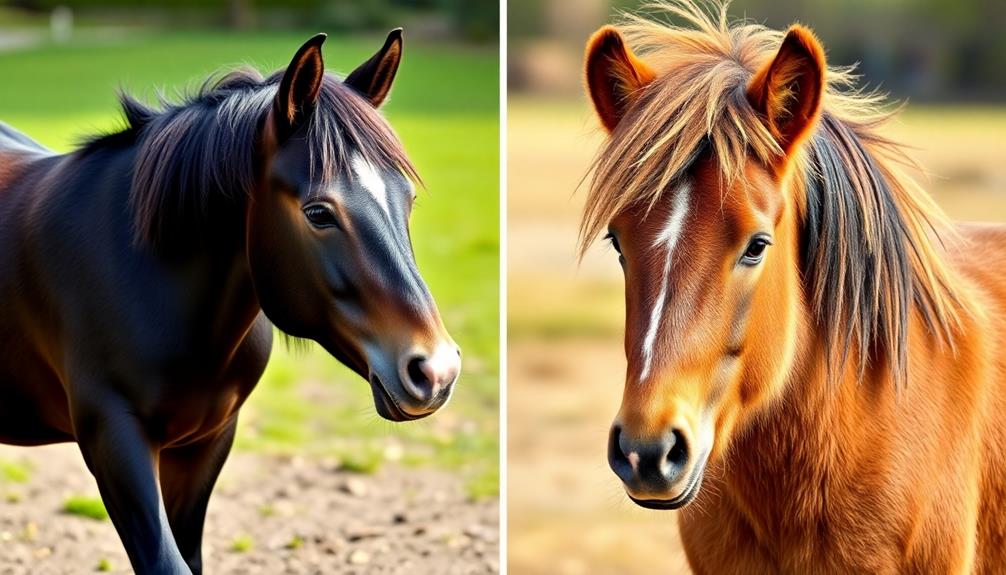
When it comes to common breeds, you'll find that the American Miniature Horse and the Shetland Pony stand out in the U.S.
Each breed has unique characteristics that cater to different needs, from the refined Falabella to the sturdy Welsh Pony.
Understanding these breeds can help you choose the right companion for your lifestyle.
Popular Miniature Horse Breeds
Miniature horses stand out for their charm and variety, with several popular miniature horse breeds capturing the hearts of enthusiasts. The American Miniature Horse is the most recognized breed in the U.S., typically maturing at a height of 34 inches. You'll find them in a rainbow of colors, making them not only adorable but also visually appealing.
Another notable breed is the Falabella, hailing from Argentina. These refined miniature horses can be as small as 28 inches tall, showcasing elegance and grace.
Unlike ponies, miniature horses are bred to resemble full-sized horses in proportion, which sets them apart in both appearance and stature.
Additionally, the Miniature Appaloosa is a delightful breed you might want to explore. This breed features the distinctive spotted coat pattern of the Appaloosa, but in a smaller frame, combining the best of both worlds.
When considering popular miniature horse breeds, remember that miniature horses typically range in height from 34 to 38 inches, which distinguishes them clearly from ponies. Each breed brings unique traits and charm, making them wonderful companions.
Notable Pony Breeds
Pony breeds offer a fascinating contrast to miniature horses, showcasing their own unique characteristics and charm. If you're considering adding a pony to your life, you'll find several notable breeds worth exploring.
Shetland ponies are among the most popular in the U.S. Known for their strength and resilience, these ponies are often used in riding schools and are great mounts for children.
The Welsh pony, originating from Wales, is versatile with types ranging from small, refined ponies to larger, robust ones.
Hackney ponies stand out with their elegant movement and high-stepping action, often participating in driving competitions. They exhibit a refined appearance that captures attention.
Dartmoor ponies, hailing from the Dartmoor region of England, are known for their good temperament, making them suitable for both riding and driving.
Lastly, the Exmoor pony, an ancient British breed, is well-adapted to harsh environments, characterized by its thick coat and distinctive look.
Each of these pony breeds presents a unique set of physical differences that set them apart from mini horses and ponies, making them special in their own right.
Breed Characteristics Comparison
Comparing breed characteristics between Miniature Horses and common pony breeds reveals distinct traits that cater to different preferences and needs.
Miniature Horses, like the American Miniature Horse, typically mature at a height of up to 34 inches and come in various colors. The Falabella, another miniature breed, can be as small as 28 inches and is known for its refined appearance.
On the other hand, ponies such as the Shetland, Welsh, New Forest, and Dartmoor have a stocky build and thicker coats. They generally range from about 12 to 14.2 hands in height, making them sturdy and suitable for children's riding.
Here's a quick comparison:
- Miniature Horses: Up to 34 inches, diverse colors, popular in the U.S.
- Falabella Miniature Horses: As small as 28 inches, refined look.
- Shetland Pony: Most prevalent in the U.S., stocky build.
- Welsh Pony: Versatile, good for riding and driving.
- Price Range: Ponies often exceed $10,000, while Miniature Horses are typically more affordable.
Understanding these traits helps you choose the right companion for your needs!
Uses and Roles
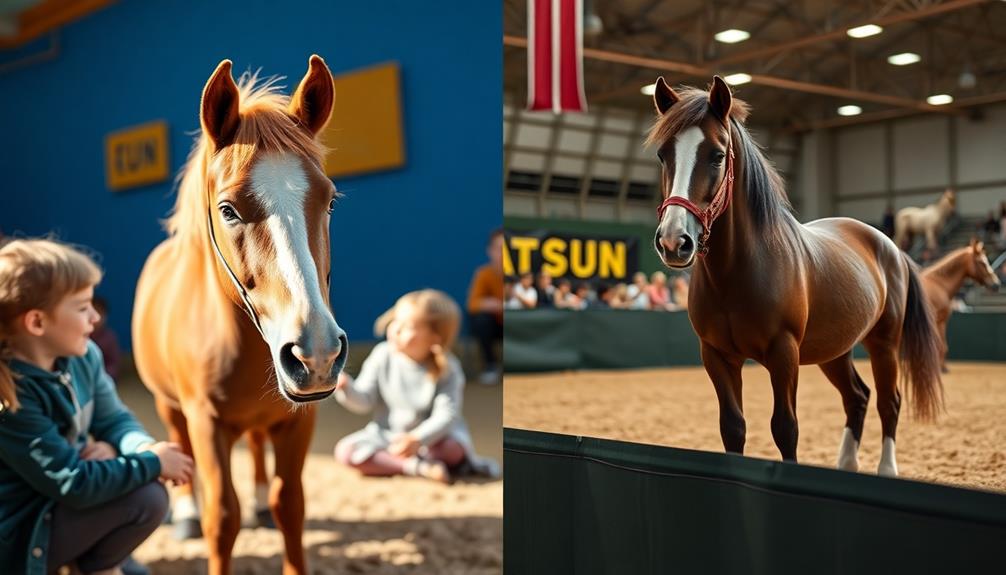
When it comes to uses and roles, both miniature horses and ponies serve distinct purposes that cater to various needs.
Miniature horses are often employed as therapy animals, bringing comfort to patients in hospitals and residents in retirement homes with their gentle nature. Their calm demeanor makes them ideal for such environments. Additionally, they can participate in driving and in-hand classes, showcasing their agility and trainability in competitive settings.
On the other hand, ponies are a favorite choice for children's mounts in various equestrian sports. Their manageable size and friendly temperament make them perfect for young riders learning the ropes. Ponies also contribute to farm work, utilizing their strength for heavier tasks where needed.
Interestingly, miniature horses are increasingly recognized as service animals, and airlines must accommodate them alongside traditional service dogs. This growing recognition highlights their versatility in providing support and companionship.
While both serve important roles, your choice between a miniature horse and a pony will depend on your specific needs, whether for therapy, competition, or work on the farm.
Ownership Considerations
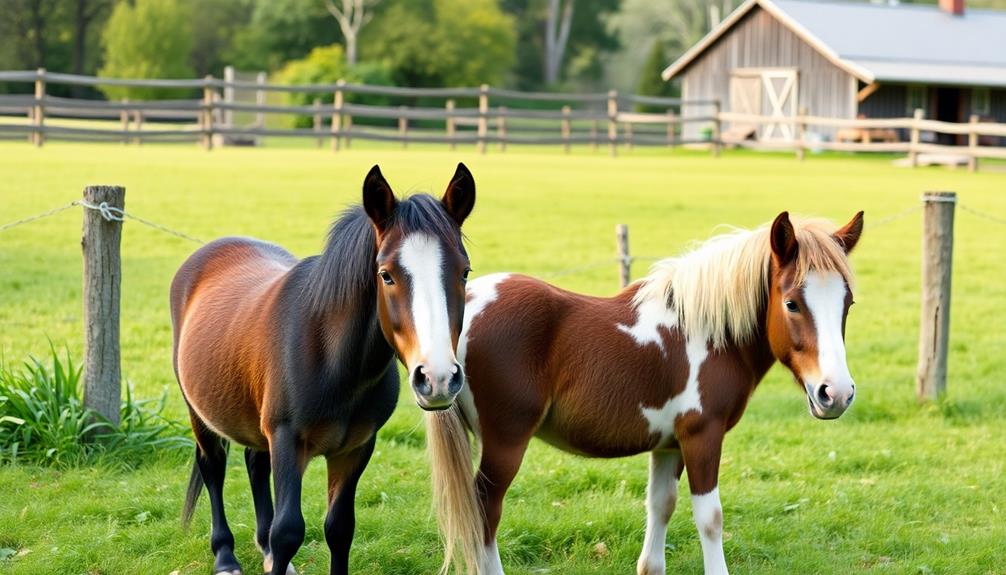
Owning a miniature horse or pony isn't just a whim; it demands a serious time commitment and ongoing financial responsibility.
You'll need to budget for everything from initial costs to regular feed and veterinary care, which can add up quickly.
Plus, these animals thrive on companionship, so be prepared to invest your time in their social needs as well.
Time Commitment Needed
Caring for a miniature horse or pony demands a significant time commitment that goes beyond casual ownership. Both types of equines require daily attention to thrive, and you need to be prepared for the responsibilities they entail.
Here are some key aspects of the time commitment involved:
- Daily feeding and care: You'll need to dedicate time for grooming, exercise, and social interaction to keep them happy.
- Regular veterinary check-ups: Expect to schedule monthly visits for vaccinations and health assessments.
- Consistent training: Allocate time for riding and training sessions to enhance your horsemanship skills.
- Routine tasks: Activities like deworming and dental exams can be time-intensive, requiring careful planning.
- Ongoing education: Understanding horse behavior and body language is essential, so be ready to invest time in learning and experience.
If you're considering bringing a miniature horse or pony into your life, be sure you can commit to these daily and monthly responsibilities.
The time you invest will ultimately lead to a rewarding bond and a happy, healthy companion.
Financial Responsibilities Overview
Understanding the time commitment involved in caring for a miniature horse or pony naturally leads to an important evaluation: financial responsibilities. The initial purchase costs can range from $1,000 to over $10,000, with ponies typically being pricier due to their higher demand and training levels.
Once you've made that initial investment, ongoing expenses like feed, bedding, and supplies can accumulate quickly. It's vital to budget for these costs, as they play a significant role in your overall financial commitment.
Veterinary care is another essential expense, including vaccinations, deworming, and dental exams, which should be incorporated into your annual budget.
Don't forget to take into account potential boarding costs, which vary widely based on facility and services, as well as unexpected emergencies or repairs that can arise.
A commitment to regular care is non-negotiable; you'll need to dedicate time for daily feeding and grooming, weekly exercise sessions, and monthly vet check-ups to guarantee your equine companion remains healthy and happy.
Community Insights
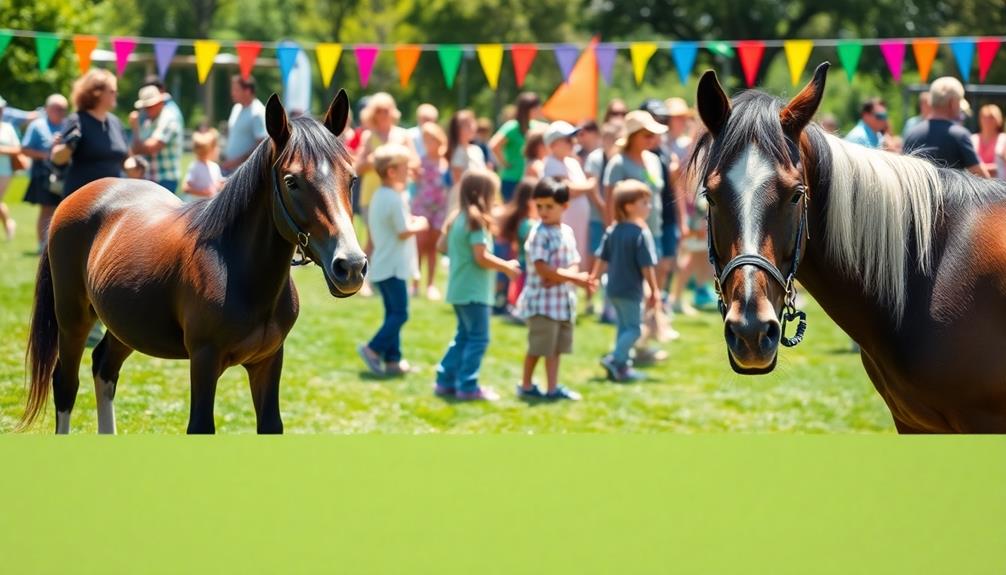
In the equestrian community, many horse owners share similar challenges and triumphs, creating a supportive environment for all. One of the most prominent issues is financial management, with 47% of owners expressing concerns about ongoing expenses.
Time constraints also affect the quality of care you can provide, impacting both you and your equine partner's experiences. However, there's a strong sense of camaraderie, as horse owners actively engage in sharing their experiences and offering support.
Here are some fun facts about the community:
- Popular disciplines include both English and Western riding, showcasing diverse interests.
- Many horse owners regularly participate in clinics and workshops to enhance their skills.
- Networking with fellow owners can lead to lifelong friendships and shared knowledge.
- Online forums and social media groups provide platforms for discussion and advice.
- Local events often host competitions, creating opportunities for community bonding.
Misconceptions and Clarifications
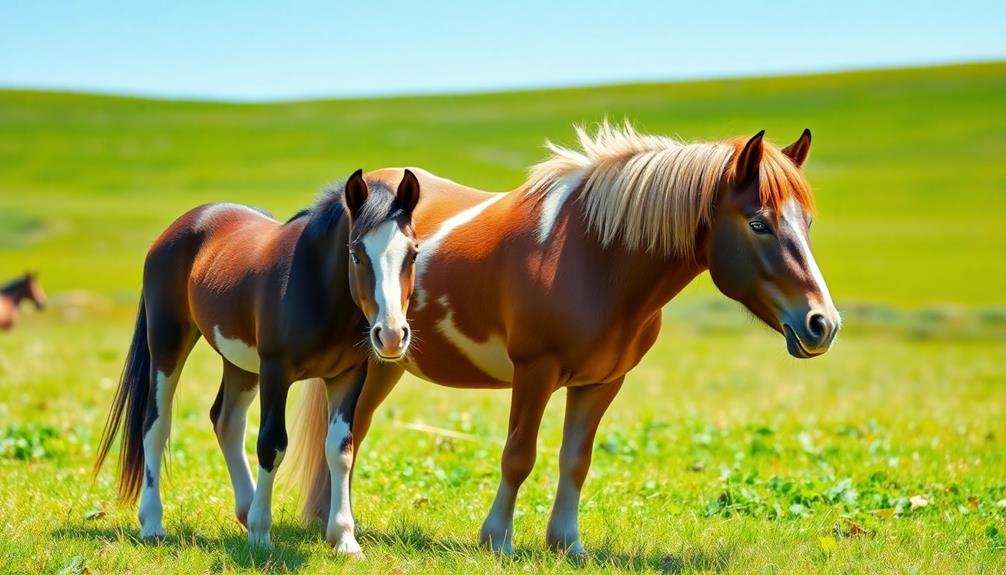
Many people assume that miniature horses and ponies are the same due to their similar small stature, but this misconception overlooks important differences between the two.
While both are small equines, miniature horses have a maximum height of 38 inches and closely resemble full-sized horses in conformation. In contrast, ponies are shorter than 14.2 hands (58 inches) and tend to have stockier builds with shorter legs and thicker necks.
Another common misunderstanding is that miniature horses can be ridden like ponies. Despite their size, miniature horses aren't suitable for carrying adult riders, while ponies can be ridden by children and small adults, making them more versatile in riding activities.
This leads to confusion about their specific characteristics and care needs.
Additionally, public perception often underestimates the care requirements of miniature horses. Many potential owners think they're easier to care for, but they actually need daily attention and social interaction to thrive.
Understanding these key differences between miniature horses and ponies is essential to guarantee proper care and appreciation for each unique breed.
Frequently Asked Questions
What's the Difference Between a Horse and Pony?
The main difference between a horse and a pony lies in their height. Horses typically stand over 14.2 hands tall, while ponies measure under that.
You'll also notice ponies tend to have stockier builds, thicker coats, and shorter legs. Their temperaments can differ too; ponies may be more mischievous, while horses are often more refined in appearance.
Both require similar care, including proper nutrition and social interaction, to thrive in their environments.
What Are the Distinguishing Characteristics of a Miniature Horse?
So, you think all small horses are just cute, furry toys? Think again!
Miniature Horses are like the elegant supermodels of the equine world. Standing at a maximum of 38 inches, they've got longer necks and straighter legs, making them look more like their full-sized counterparts.
Bred for companionship and service, these gentle creatures are both trainable and adorable. They might be small, but don't underestimate their charm and refined stature!
What Is the Difference Between a Mini Horse and a Shetland Pony?
When you're comparing a mini horse to a Shetland pony, height and build are key factors.
Mini horses stand under 38 inches tall and are proportionate like larger horses, while Shetland ponies can reach up to 46 inches and have a stockier frame.
Additionally, Shetland ponies are often stronger and used for riding, whereas mini horses are primarily companions or therapy animals.
Their dietary needs also differ, with ponies needing more calories.
What Is the Difference Between a Miniature Horse and a Dwarf Horse?
When you compare a miniature horse to a dwarf horse, you'll notice key differences in breeding and health.
Miniature horses are selectively bred to maintain specific traits and conform to breed standards, usually standing under 38 inches tall.
Dwarf horses, however, result from genetic mutations, leading to disproportionate features and potential health issues.
While minis can participate in competitions, dwarf horses often face limitations due to their physical challenges.
Conclusion
In wrapping up, whether you're drawn to the delightful dimensions of miniature horses or the playful personalities of ponies, both bring joy and companionship. Understanding their unique traits can help you choose the perfect partner for your needs. So, immerse yourself in this delightful decision with confidence, and don't let common misconceptions muddle your mind. With the right knowledge, you'll foster a fabulous friendship that flourishes through fun and frolic!
